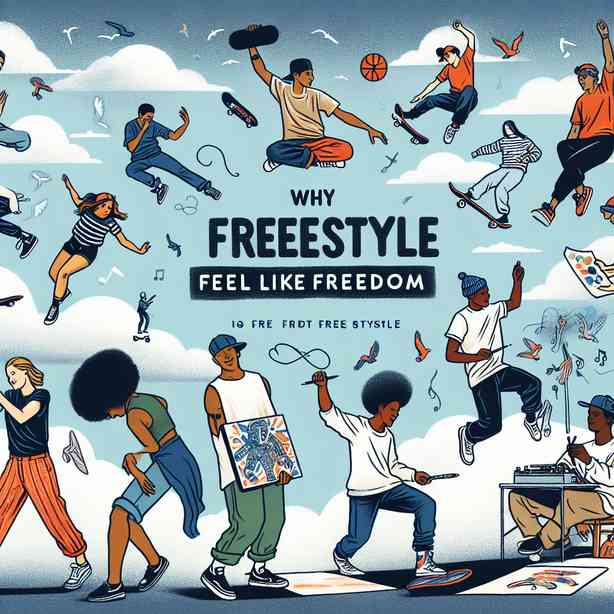
Freestyle, as a form of expression, embodies a unique blend of creativity, spontaneity, and personal connection. It transcends mere technical skills and taps into an intrinsic sense of freedom that resonates deeply with performers and audiences alike. When one engages in freestyle—be it in rap, dance, or any improvisational art form—they embrace a state of being where the constraints of structure and expectation fall away, allowing pure expression to flourish.
At its core, freestyle offers a platform for self-exploration and authenticity. Unlike pre-composed works, which can sometimes feel rigid or contrived, freestyle invites artists to tap into their emotions, experiences, and thoughts in real time. This immediacy fosters an exhilarating atmosphere that not only captivates those involved but also shares a sense of intimacy with the audience. The performer reveals their vulnerabilities, thoughts, and feelings, creating a compelling narrative that resonates on multiple levels.
The freedom expressed through freestyle comes from the ability to break away from societal norms and boundaries. Artists can explore unconventional themes, challenge stereotypes, and express dissenting viewpoints without the fear of being pigeonholed. This aspect of freestyle is particularly important in today’s world, where self-expression is often stifled by commercial expectations, social pressures, and cultural constraints. By embracing freestyle, artists reclaim their voice and remind the world that creativity knows no boundaries.
Moreover, freestyle generates a powerful communal experience. In many freestyle communities, such as rap battles or dance circles, artists come together in a shared space of creativity and support. This nurturing environment encourages collaboration, inspiration, and growth. Each participant contributes their unique energy, reinforcing the idea that artistry thrives in community. The spontaneous nature of freestyle creates a feedback loop, where performers can learn from one another and build upon each other’s ideas. In this way, freestyle becomes not only an individual expression but also a collaborative form that highlights the beauty of shared creativity.
Freestyling also serves as a form of mental and emotional release. For many artists, the pressures of daily life can be overwhelming. Engaging in freestyle allows them to channel their anxiety, joy, frustrations, and triumphs into their performance. This therapeutic quality of freestyle can lead to significant personal growth and healing. Artists find solace in the fact that they can share their story, connect with others, and leave their burdens behind, if only for a moment.
In addition to the personal benefits, freestyle plays a crucial role in cultural preservation and evolution. It provides a platform for marginalized voices to be heard and celebrated. Through freestyle, artists can draw from their heritage, infusing their performances with cultural references, storytelling, and traditions. This blend of past and present creates a rich tapestry that honors history while also pushing boundaries forward. Each freestyle performance is like a living document, capturing the essence of its time and place, thus contributing to the ongoing evolution of culture.
Technology has also impacted the world of freestyle significantly. With the rise of social media platforms, artists can now share their freestyle performances with a global audience, exponentially increasing their reach. This accessibility democratizes the art form, allowing anyone with a device to participate in or witness freestyle culture. As a result, new voices emerge, and diverse styles blend, further enriching the collective tapestry of freestyle. It fosters a sense of unity among artists from various backgrounds, encouraging cross-cultural collaborations and inspiring innovative fusions.
The educational aspect of freestyle cannot be overlooked either. Many artists and educators now recognize the potential of improvisational techniques to develop critical thinking, creativity, and collaboration skills. Freestyle workshops are becoming increasingly popular in educational settings, emphasizing the value of spontaneity and expression. Students learn to trust their instincts, build confidence, and communicate effectively in the moment. This approach not only benefits aspiring artists but also cultivates valuable life skills that extend beyond the stage.
As you delve deeper into the world of freestyle, it becomes clear that it is not just about individual expression but rather a rich interplay of community, culture, and creativity. The notion of freedom in freestyle lies in the endless possibilities it presents—each performance is unique, a one-of-a-kind glimpse into the artist’s mind and heart. The fluidity of freestyle serves as a reminder that art is an ever-evolving journey, where each moment offers a new opportunity for exploration and connection.
In conclusion, the feeling of freedom within freestyle is multifaceted, encompassing personal, communal, and cultural dimensions. It invites artists to break free from constraints, express their true selves, and foster connections with others. Whether you are an artist or an audience member, engaging with freestyle provides an enriching experience that transcends the ordinary. It’s a celebration of creativity in its purest form, a call to embrace spontaneity, and an invitation to explore the limitless horizons of artistic expression. So, let us celebrate and support the freestyle movement, as it continues to inspire, challenge, and unite us all. Through freestyle, we truly find freedom—not just in the art itself, but in the shared human experience that it represents.


